
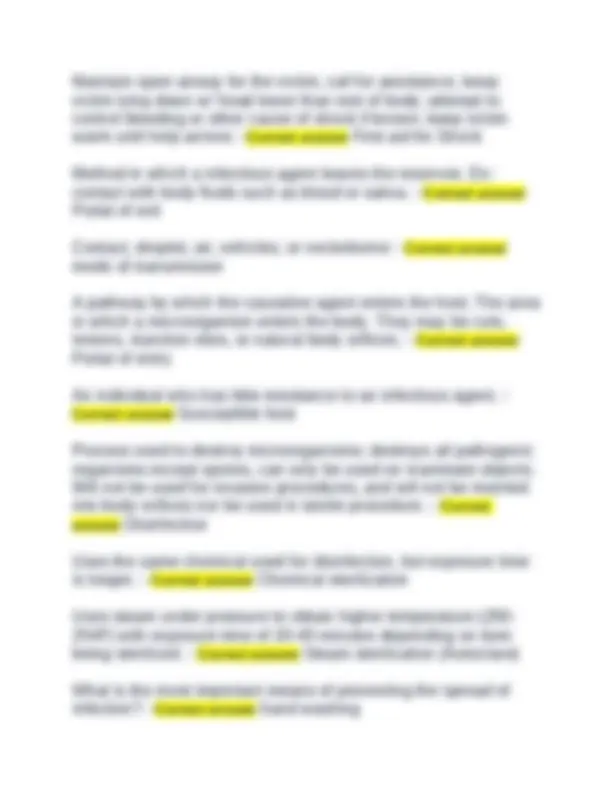
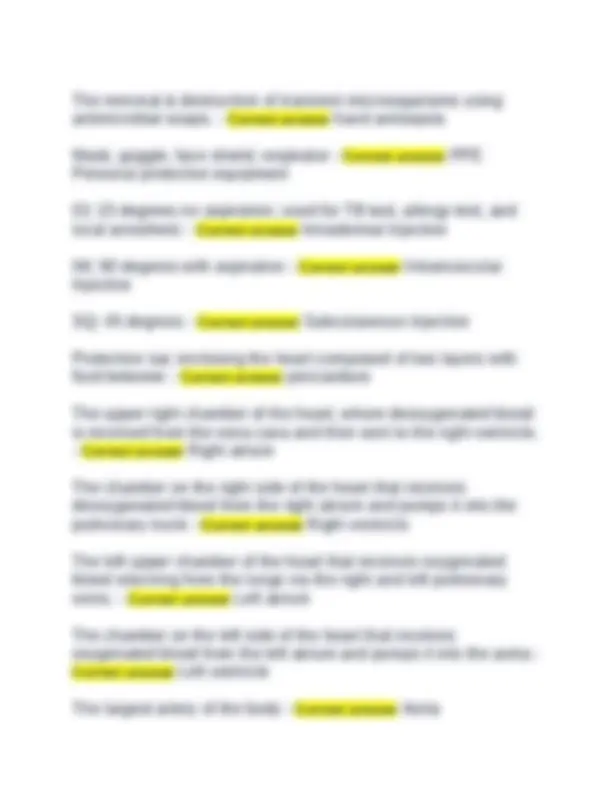
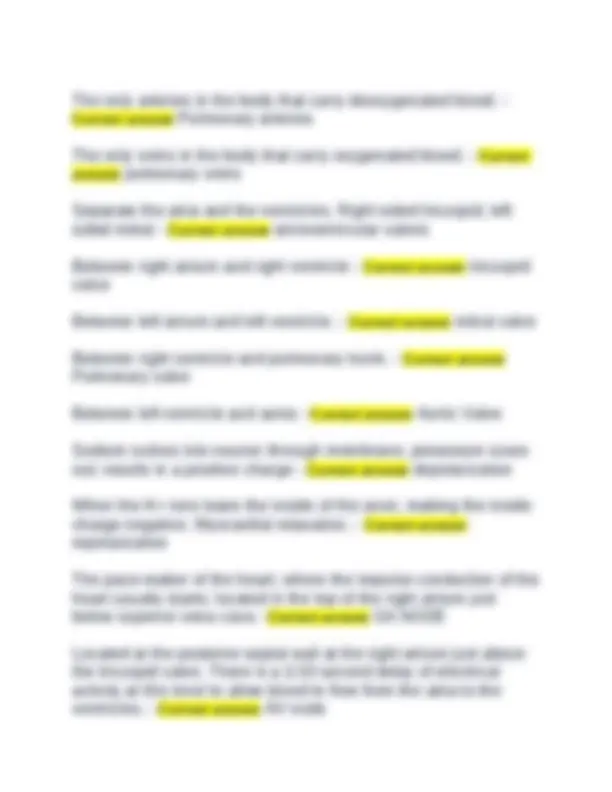
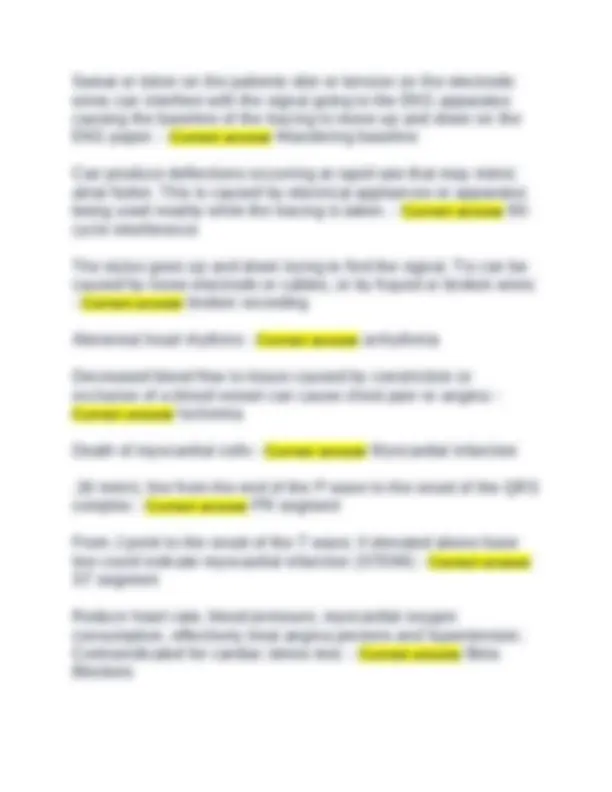
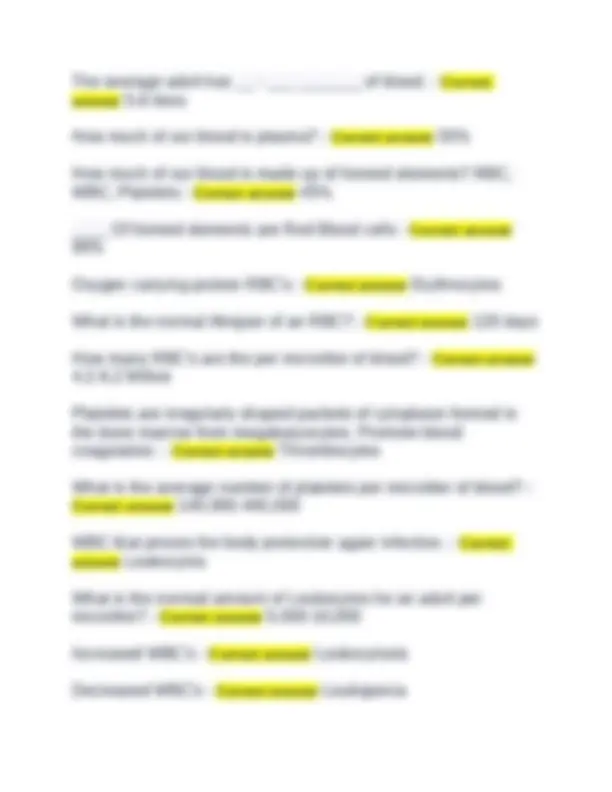
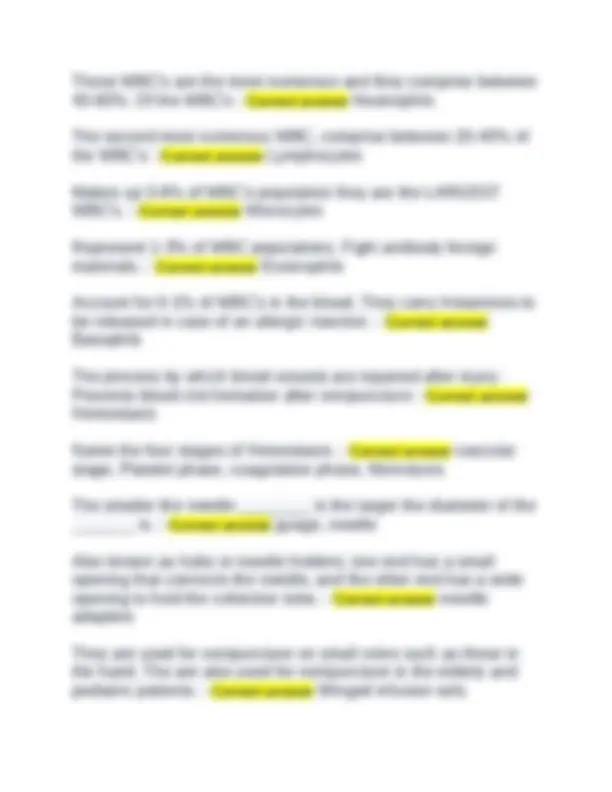
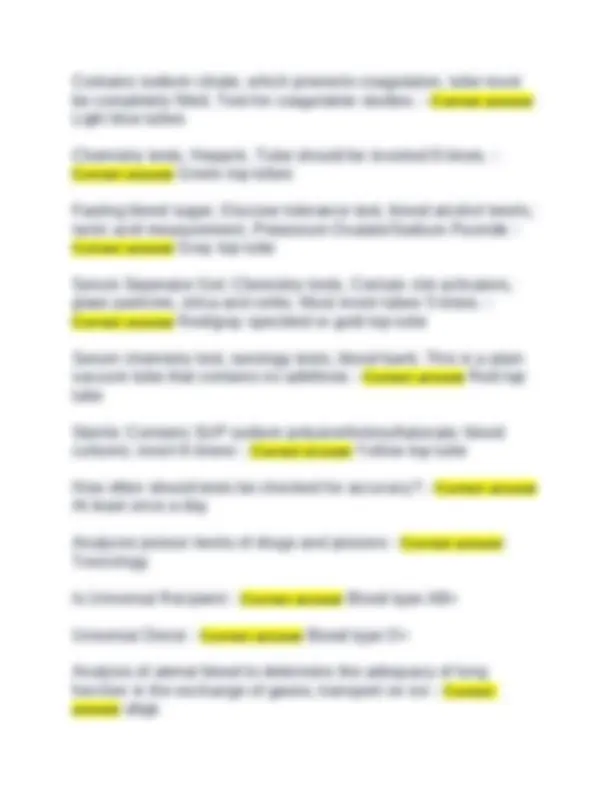
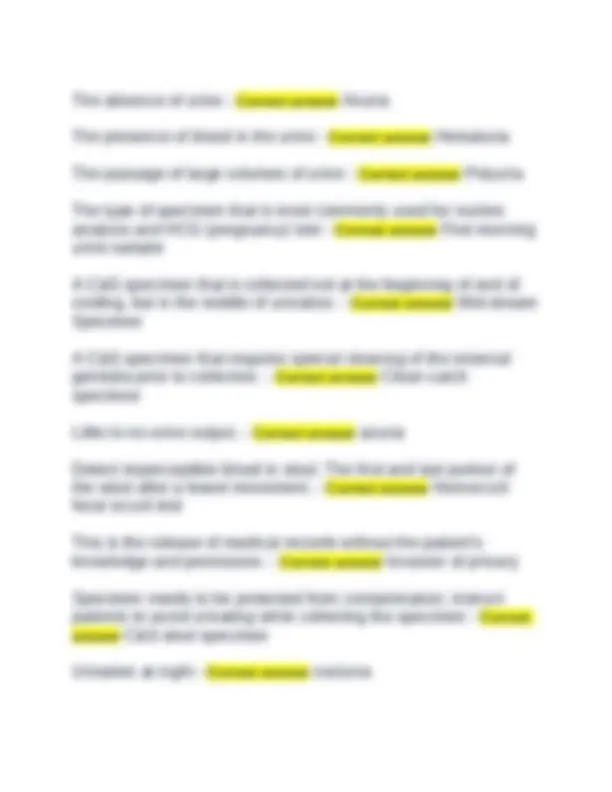
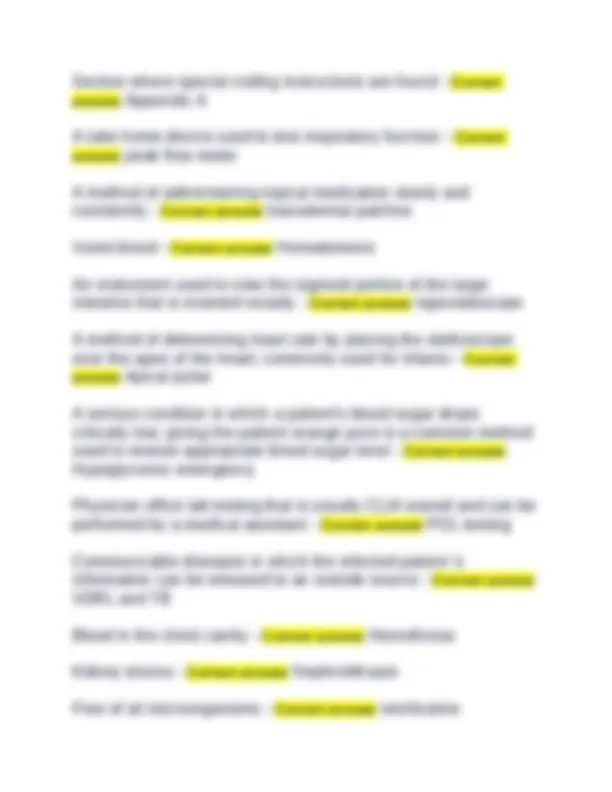


Study with the several resources on Docsity

Earn points by helping other students or get them with a premium plan


Prepare for your exams
Study with the several resources on Docsity

Earn points to download
Earn points by helping other students or get them with a premium plan
Community
Ask the community for help and clear up your study doubts
Discover the best universities in your country according to Docsity users
Free resources
Download our free guides on studying techniques, anxiety management strategies, and thesis advice from Docsity tutors
CCMA Certification Study Guide Questions And Answers.CCMA Certification Study Guide Questions And Answers.
Typology: Exams
1 / 16

This page cannot be seen from the preview
Don't miss anything!










The reason a patient called for help. Also, the patient's response to questions such as "What's wrong?" or "What happened?" - Correct answer Chief complaint CC Explains the chief complaint. A chronological description of the development of the patient's present illness from the first sign or symptom or from the previous encounter to the present. - Correct answer History of present illness HPI Temperature, pulse, respiration, and Blood pressure are all ___________ ___________. - Correct answer Vital Signs 97.6F - 99.6F - Correct answer Normal oral temperature Fever that alternates between elevated and normal or subnormal body temperatures. - Correct answer intermittent fever Fever in which temperature fluctuates greatly but never falls to the normal level. - Correct answer Remittent fever A fever that remains constant above the baseline, does not fluctuate. - Correct answer Continuous fever Normal pulse rate - Correct answer 60-100 BPM Rate, rhythm, and depth are taken into account when measuring what? - Correct answer Respirations Contraction of the heart - Correct answer Systole Relaxation of the heart - Correct answer Diastole
Measurement of height, (length rather than height is used in infants because they cannot stand.), weight, BMI, head circumference in infants, waist to hip, % of body fat. - Correct answer Anthropometric measurements General appearance, state of nutrition, body habits, symmetry, pasture and gait, speech. - Correct answer Inspection To examine by touch - Correct answer palpation Physical examination method of tapping over the body to elicit vibrations and sounds to estimate the size, border, or fluid content of a cavity such as the chest. - Correct answer Percussion The act of listening to sounds arising within organs (as the lungs or heart) as an aid to diagnosis and treatment. - Correct answer Ausculation A government agency in the Department of Labor to maintain a safe and healthy work environment - Correct answer OSHA An emergency procedure for life support consisting of artificial respiration and manual external cardiac compression - Correct answer cardiopulmonary resuscitation This is caused by inadequate blood flow to the heart and in turn to the rest of the body. - Correct answer SHOCK Pale, cold, clammy skin Rapid, weak pulse Increased shallow breathing Expressionless face or staring eyes are all ____________ ___ _________. - Correct answer Symptoms of shock
The removal & destruction of transient microorganisms using antimicrobial soaps. - Correct answer hand antisepsis Mask, goggle, face shield, respirator - Correct answer PPE Personal protective equipment ID; 15 degrees no aspiration; used for TB test, allergy test, and local anesthetic - Correct answer Intradermal Injection IM; 90 degress with aspiration - Correct answer Intramuscular Injection SQ; 45 degress - Correct answer Subcutaneous Injection Protective sac enclosing the heart composed of two layers with fluid between - Correct answer pericardium The upper right chamber of the heart, where deoxygenated blood is received from the vena cava and then sent to the right ventricle.
The only arteries in the body that carry deoxygenated blood. - Correct answer Pulmonary arteries The only veins in the body that carry oxygenated blood. - Correct answer pulmonary veins Separate the atria and the ventricles. Right sided tricuspid, left sided mitral - Correct answer atrioventricular valves Between right atrium and right ventricle - Correct answer tricuspid valve Between left atrium and left ventricle. - Correct answer mitral valve Between right ventricle and pulmonary trunk. - Correct answer Pulmonary valve Between left ventricle and aorta - Correct answer Aortic Valve Sodium rushes into neuron through membrane, potassium ruses out; results in a positive charge - Correct answer depolarization When the K+ ions leave the inside of the axon, making the inside charge negative. Myocardial relaxation. - Correct answer repolarization The pace-maker of the heart; where the impulse conduction of the heart usually starts; located in the top of the right atrium just below superior vena cava - Correct answer SA NODE Located at the posterior septal wall at the right atrium just above the tricuspid valve. There is a 1/10 second delay of electrical activity at this level to allow blood to flow from the atria to the ventricles. - Correct answer AV node
1 large square on EKG grid is equal to - Correct answer 5mm 2 large squares on EKG grid is equal to - Correct answer 1mv 1 small square on ekg grid is equal to how much time? - Correct answer .04 seconds or 40m seconds 1 large square on ekg grid is equal to how much time? - Correct answer .2 seconds or 200m seconds 5 large squares on ekg grid is equal to how much time? - Correct answer 1 second or 1000 m seconds The running speed of an EKG is? - Correct answer 25mm per second What represents time on an EKG? - Correct answer Horizontal axis What represents amplitude on an EKG? - Correct answer Vertical axis Deflection produced by Atrial depolarization. Normal range does not exceed 0.11s in duration or 2.55mm in height. - Correct answer P Wave Deflection produced by ventricular repolarization - Correct answer T wave Ventricular depolarization - Correct answer QRS complex Patients tremors or shaking the wires can produce jittery patterns on the EKG tracing. - Correct answer Somatic tremors
Sweat or lotion on the patients skin or tension on the electrode wires can interfere with the signal going to the EKG apparatus causing the baseline of the tracing to move up and down on the EKG paper. - Correct answer Wandering baseline Can produce deflections occurring at rapid rate that may mimic atrial flutter. This is caused by electrical appliances or apparatus being used nearby while the tracing is taken. - Correct answer 60- cycle interference The stylus goes up and down trying to find the signal. Tis can be caused by loose electrode or cables, or by frayed or broken wires
These WBC's are the most numerous and they comprise between 40-60%. Of the WBC's - Correct answer Neutrophils The second most numerous WBC, comprise between 20-40% of the WBC's - Correct answer Lymphocytes Makes up 3-8% of WBC's population they are the LARGEST WBC's. - Correct answer Monocytes Represent 1-3% of WBC populations. Fight antibody foreign materials. - Correct answer Eosinophils Account for 0-1% of WBC's in the blood. They carry histamines to be released in case of an allergic reaction. - Correct answer Basophils The process by which blood vessels are repaired after injury. Prevents blood clot formation after venipuncture - Correct answer Hemostasis Name the four stages of Hemostasis. - Correct answer vascular stage, Platelet phase, coagulation phase, fibrinolysis The smaller the needle ________ is the larger the diameter of the _______ is. - Correct answer guage, needle Also known as hubs or needle holders; one end has a small opening that connects the needle, and the other end has a wide opening to hold the collection tube. - Correct answer needle adapters They are used for venipuncture on small veins such as those in the hand. The are also used for venipuncture in the elderly and pediatric patients. - Correct answer Winged infusion sets
The vein of choice because is it large and does not tend to move the the needle is inserted. - Correct answer median cubital vein The second choice for venipuncture. It is usually more difficult to locate and has a tendency to move, however, it is often the only vein that can be palpated in the obese patients. - Correct answer Cephalic vein The third choice for venipunctures. It is the least firmly anchored and located near the brachial artery. If the needle is inserted too deep, this artery may be punctured. - Correct answer Basilic Vein Where should the tourniquet be placed when performing venipuncture? - Correct answer 3-4 inches above the venipuncture site What is the correct order of Draw? - Correct answer 1. Blood cultures,
Contains sodium citrate, which prevents coagulation, tube must be completely filled. Test for coagulation studies. - Correct answer Light blue tubes Chemistry tests. Heparin. Tube should be inverted 8 times. - Correct answer Green top tubes Fasting blood sugar, Glucose tolerance test, blood alcohol levels, lactic acid measurement. Potassium Oxalate/Sodium Fluoride - Correct answer Gray top tube Serum Seperator Gel; Chemistry tests. Contain clot activators, glass particles, silica and celite. Must invert tubes 5 times. - Correct answer Red/gray speckled or gold top tube Serum chemistry test, serology tests, blood bank. This is a plain vacuum tube that contains no additives - Correct answer Red top tube Sterile; Contains SUP sodium polyanetholesulfatonate; blood cultures; invert 8 times/ - Correct answer Yellow top tube How often should tests be checked for accuracy? - Correct answer At least once a day Analyzes poison levels of drugs and poisons - Correct answer Toxicology Is Universal Recipient - Correct answer Blood type AB+ Universal Donor - Correct answer Blood type O+ Analysis of aterial blood to determine the adequacy of lung function in the exchange of gases; transport on ice - Correct answer abgs
The absence of urine - Correct answer Anuria The presence of blood in the urine - Correct answer Hematuria The passage of large volumes of urine - Correct answer Polyuria The type of specimen that is most commonly used for routine analysis and HCG (pregnancy) test - Correct answer First morning urine sample A C&S specimen that is collected not at the beginning of end of voiding, but in the middle of urination. - Correct answer Mid-stream Specimen A C&S specimen that requires special cleaning of the external genitalia prior to collection. - Correct answer Clean-catch specimen Little to no urine output. - Correct answer anuria Detect imperceptible blood in stool. The first and last portion of the stool after a bowel movement. - Correct answer Hemoccult fecal occult test This is the release of medical records without the patient's knowledge and permission. - Correct answer Invasion of privacy Specimen needs to be protected from contamination; instruct patients to avoid urinating while collecting the specimen - Correct answer C&S stool specimen Urination at night - Correct answer nocturia
Profuse sweating - Correct answer diaphoresis Infections derived from the patient staying in the hospital - Correct answer Nosocomial infections Identify conditions other than a disease or injury, but are not necessarily a primary diagnosis - Correct answer V codes